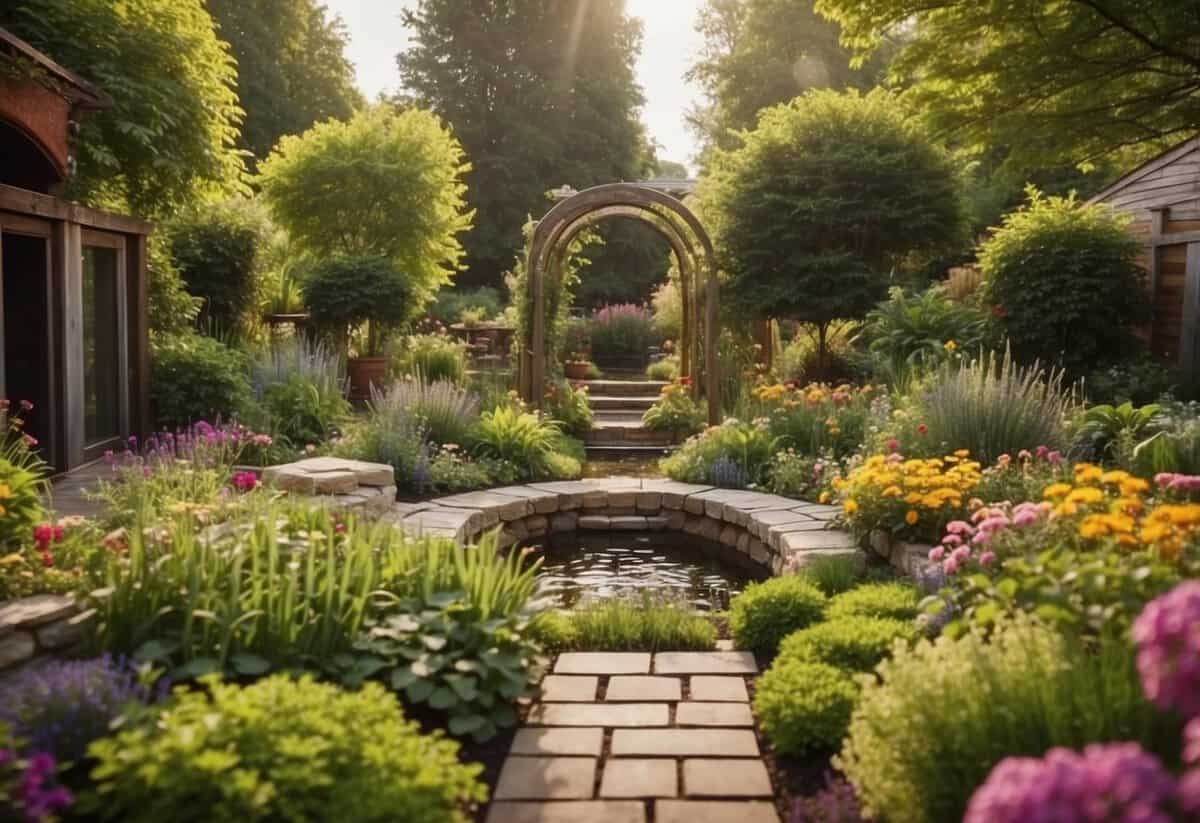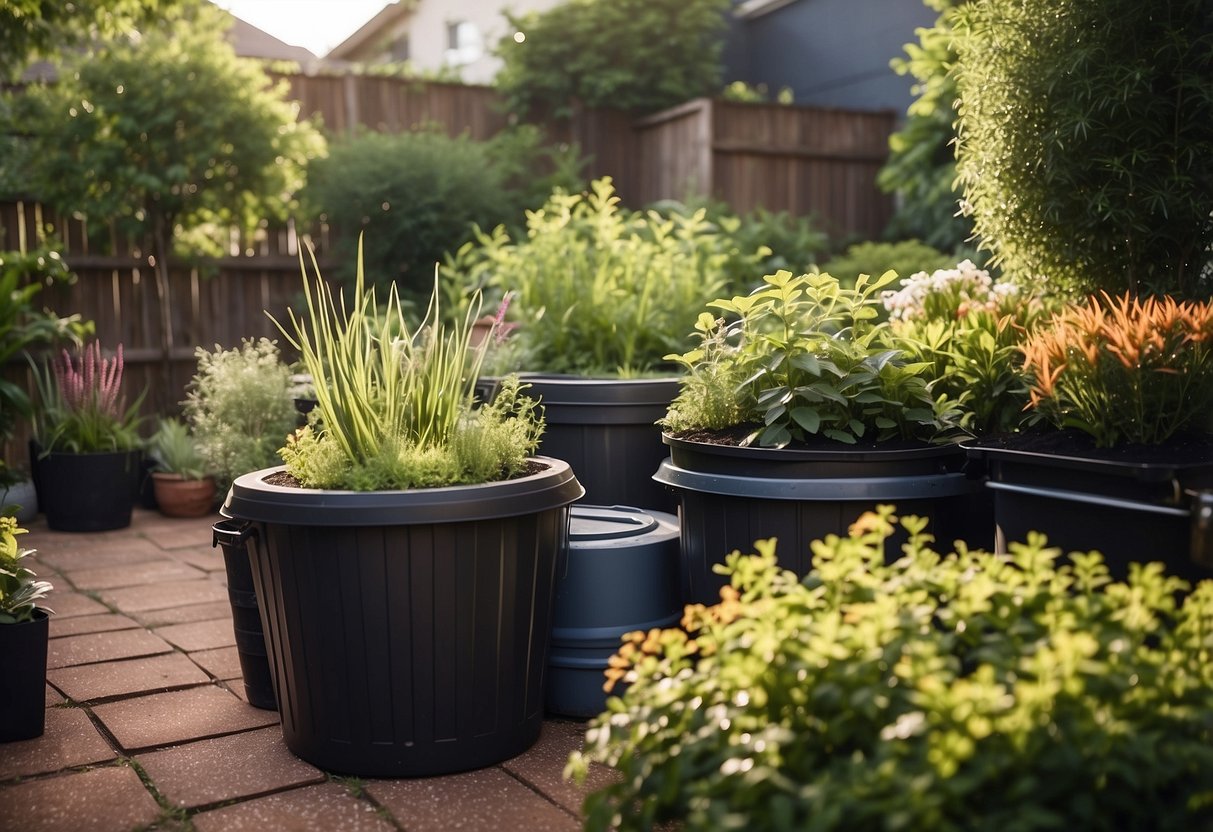Garden Design Hacks: Easy Tips for a Stunning Yard
Creating a beautiful garden doesn’t have to be difficult or costly. There are many clever tricks and tips you can use to transform your outdoor space with minimal effort and expense. Imagine having a vibrant garden where each corner bursts with personality and charm.

How can you achieve a stunning garden without breaking the bank? By using simple garden design hacks, you can repurpose everyday items and make the most of what you already have. Following these tips will not only make your garden look amazing but also enhance your gardening experience.
1) Vertical Gardening

Vertical gardening is a great way to maximize your garden space. By growing plants upwards, you can fit more greenery into small areas, like patios or balconies.
Consider using a wood slat fence with planters. This design can transform a plain fence into a lush, vibrant wall.
Another idea is a strawberry tower garden. It’s perfect for growing trailing plants and utilizing leftover materials.
A hydroponic vertical garden can also save space and grow up to 100 plants in less than 10 sq ft.
2) DIY Garden Trellis

Creating a DIY garden trellis is a simple way to add charm and function to your garden. With some bamboo poles and twine, you can set up a pea trellis in no time. This is a fun project, especially if you involve kids.
For a different look, consider building a teepee trellis using bamboo stakes. It takes up very little space when not in use.
If you have some spare wood, a triangular trellis can be used for beans, peas, or cucumbers. It’s a great way to maximize your growing area.
3) Compost Tea for Plants

Compost tea is a fantastic way to boost your garden’s health. It’s like a natural, nutrient-rich drink for your plants.
To make compost tea, start with non-chlorinated water. You can achieve this by using rainwater or letting tap water sit for 24 hours.
Add about 1-2 cups of worm castings or compost into the water. This will be your inoculant.
Add a food source for the microbes, such as molasses or fish emulsion. Stir the mixture well and let it sit for 3-10 days.
Once ready, strain the mixture and apply it to your plant’s soil. This will give them a nutritious boost that can encourage growth and health. For more detailed instructions, visit Eartheasy.
4) Repurpose Old Furniture

Repurposing old furniture is a great way to add unique touches to your garden.
Turn your old dresser into a succulent planter. Keeping the mirror adds depth, making your garden look larger.
You can also repurpose patio furniture. Create a side table by cutting down an old chair.
Old doors and tables can become charming garden benches. These items add character and functionality to your outdoor space.
5) Mulching for Weed Control

Mulching is one of the easiest and most effective ways to control weeds in your garden. By covering the soil with mulch, you block sunlight from reaching weed seeds, which prevents them from germinating.
You can use different types of mulch for this purpose. Organic mulches, like wood chips or shredded leaves, also add nutrients to the soil as they decompose.
For a low-maintenance option, consider living mulch. This method uses ground-cover plants to keep weeds at bay. It’s a sustainable choice that reduces the need for traditional mulching materials.
Remember to mulch early in the season to get the best results. Adding a layer of mulch as soon as you plant your garden helps you start reaping the benefits right away.
6) Companion Planting Strategies

Companion planting is a smart way to grow a thriving garden. By planting certain crops together, you can boost growth, repel pests, and improve soil health. For example, garlic and potatoes make a great pair since garlic protects potatoes from aphids.
The well-known “three sisters” planting method involves corn, beans, and squash. Corn provides support for beans, beans add nitrogen to the soil, and squash covers the ground to retain moisture and prevent weeds.
Try growing tomatoes with basil. Basil strengthens tomato growth and can reduce pests like whiteflies.
7) Rainwater Harvesting

Rainwater harvesting is a smart way to use natural resources in your garden. It involves collecting and storing rainwater for later use. This can help you save on water bills and reduce your environmental footprint.
You can create a simple rainwater catchment system using barrels or larger tanks to store water. It’s effective for watering lawns and gardens.
Rainwater harvesting can also increase your garden’s resilience by providing a steady water supply during dry periods.
Using rainwater is also better for your plants because it doesn’t contain the chemicals found in tap water.
8) Use of Garden Mirrors

Garden mirrors can transform your outdoor space. They reflect light, making your garden look bigger and brighter.
You can place mirrors on fences or walls to create the illusion of depth. A secret mirror door adds a touch of mystery.
Putting a mirror on your potting bench brightens up shady corners. Even a small mirror can make a big difference in how your garden feels.
Try using window-style mirrors for a charming effect. They can make it seem like there’s a hidden garden just beyond the wall.
9) Homemade Insecticidal Soap

You can make your own insecticidal soap to protect your garden. It’s simple and effective!
Mix 1 tablespoon of mild liquid soap with 1 quart of water. Make sure to use pure liquid soap, not detergent.
Spray this mixture on your plants in the early morning or evening. Focus on the undersides of leaves where pests tend to hide. For more tips, check out this guide on insecticidal soap.
10) Solar Garden Lights

Solar garden lights are a brilliant way to add charm and functionality to your yard. They come in many shapes and sizes, from simple stake lights to decorative lanterns.
You can use them to line pathways, highlight garden beds, or create a magical ambiance for evening gatherings. These lights charge through the day and automatically illuminate when the sun goes down.
Get creative with projects like turning flower pots into lighthouses with solar lights on top. For budget-friendly options, check out Dollar Tree solar light hacks to enhance your garden without breaking the bank.
Design Principles for Small Gardens

In small gardens, smart design choices can help make the most of limited space. Prioritize vertical structures and focal points to enhance both aesthetics and functionality.
Utilizing Vertical Space
Vertical gardening is a great way to maximize space. Use trellises, arched trellises, or arbors to allow climbing plants to grow upwards instead of outwards. These structures not only save ground space but also create a lush, green wall effect.
In addition, hanging pots and wall planters can add more plant variety without taking up much room. Vertical space is ideal for growing herbs, flowers, and even some vegetables. Ensure the containers are securely fastened and have proper drainage to keep plants healthy.
Shelves are another useful addition. By installing tiered plant stands or shelves, you can organize pots and garden tools, keeping the ground area cleaner and more spacious. Vertical elements can also add visual interest to a garden, making it appear larger and more dynamic.
Creating Focal Points
A well-placed focal point draws attention and provides a visual anchor. This could be anything from a water feature to a beautiful plant or sculpture. In small gardens, focal points help direct the viewer’s gaze, giving the space a more organized and intentional feel.
Consider adding a colorful flower bed or a unique garden ornament as a centerpiece. An arched trellis covered in climbing vines can also serve as a stunning focal point while adding height.
You can also incorporate seating areas to create a cozy atmosphere. A small bench or a pair of chairs can be both functional and decorative. Make sure the focal point blends well with the overall design and doesn’t overcrowd the space. For more ideas, you can explore different small garden ideas.
By thoughtfully designing your small garden with vertical elements and engaging focal points, you can create a beautiful and functional outdoor space.
Innovative Plant Selection

Choosing the right plants can transform your garden into a low-maintenance, beautiful haven. By selecting low-maintenance and native species, you can enjoy a thriving garden with less effort.
Choosing Low-Maintenance Plants
Low-maintenance plants make gardening easier and more enjoyable. These plants require minimal watering, pruning, and care, allowing you to spend less time on upkeep and more time enjoying your garden.
Some great options include succulents, which store water in their leaves and thrive in various conditions. Perennials are another choice, as they come back year after year without needing to be replanted. Consider plants like hostas and daylilies for their hardiness and ability to thrive with minimal attention.
Using mulch around these plants can help retain moisture and reduce the need for frequent watering. By choosing low-maintenance plants, you not only save time but also ensure a resilient and attractive garden.
Incorporating Native Species
Incorporating native species into your garden is a smart and environmentally friendly choice. Native plants are naturally adapted to your local climate and soil conditions, making them easier to grow and maintain.
Native species, such as milkweed or coneflowers, support local wildlife, including pollinators like bees and butterflies. These plants tend to be more resistant to local pests and diseases, reducing the need for chemical treatments.
Creating a garden with native plants can enhance biodiversity and promote a healthier ecosystem. A diverse garden with native plants is more sustainable and provides a beautiful, natural look that complements your local environment.
By selecting plants that are well-suited to your region, you can enjoy a flourishing garden with less effort and a greater positive impact on the environment.
Sustainable Garden Design

Creating a sustainable garden involves using practices that help conserve resources and protect the environment. Two key areas to focus on are water conservation and the use of eco-friendly materials.
Water Conservation Techniques
One important way to make your garden more sustainable is by conserving water. Collecting rainwater is an effective method. You can set up a water butt or a large container to gather rainwater from your downpipes. This collected water can then be used to irrigate your plants.
Drip irrigation systems are another great choice. They deliver water directly to the plant roots, reducing wastage. Mulching is also beneficial as it helps retain soil moisture and reduce evaporation. Using organic mulch, such as wood chips or straw, adds nutrients to the soil while conserving water.
Selecting drought-tolerant plants can further reduce water usage. Plants like lavender, succulents, and ornamental grasses require less water to thrive. Overall, these techniques help you maintain a lush garden with minimal water use.
Using Eco-Friendly Materials
Opting for eco-friendly materials in your garden design is essential for sustainability. Permeable surfaces, such as gravel or permeable pavers, allow rainwater to seep into the ground, reducing runoff and erosion. This helps in maintaining the natural water cycle.
Recycled materials can be used creatively in your garden. Items like reclaimed wood, old bricks, and recycled metal can be transformed into garden borders, pathways, or even garden furniture. These materials add unique character to your garden and reduce waste.
Incorporating organic fertilizers, like homemade compost or natural mulch, is another practice. These materials enrich the soil without the harmful chemicals found in synthetic fertilizers. This promotes healthier plants and supports local wildlife, making your garden both beautiful and eco-friendly.
Using these sustainable practices ensures your garden is not only environmentally friendly but also a thriving natural space.







